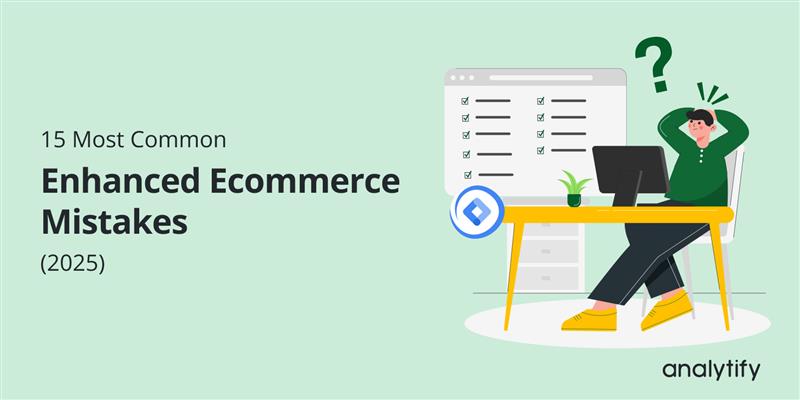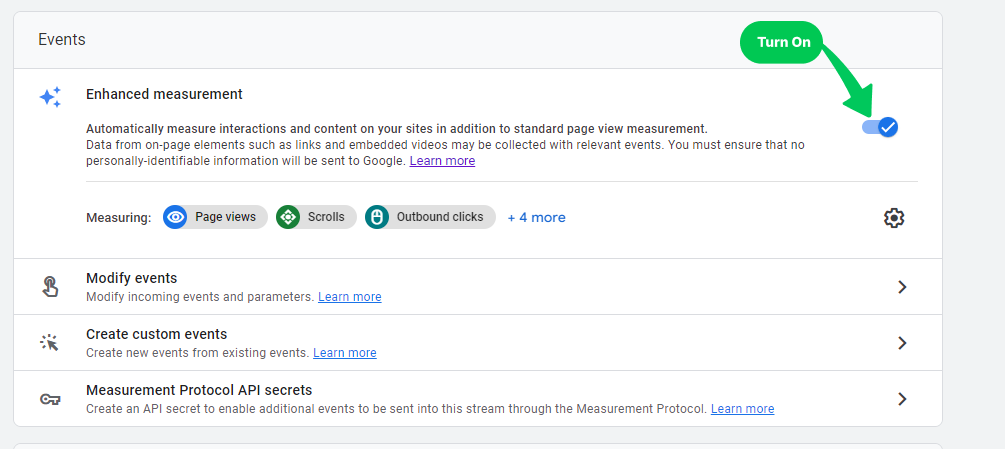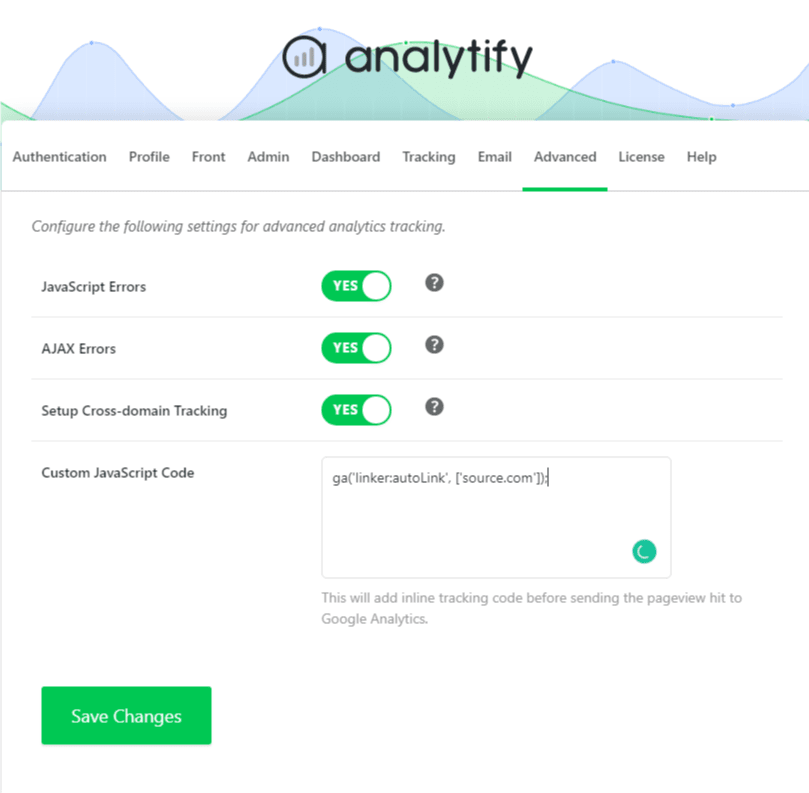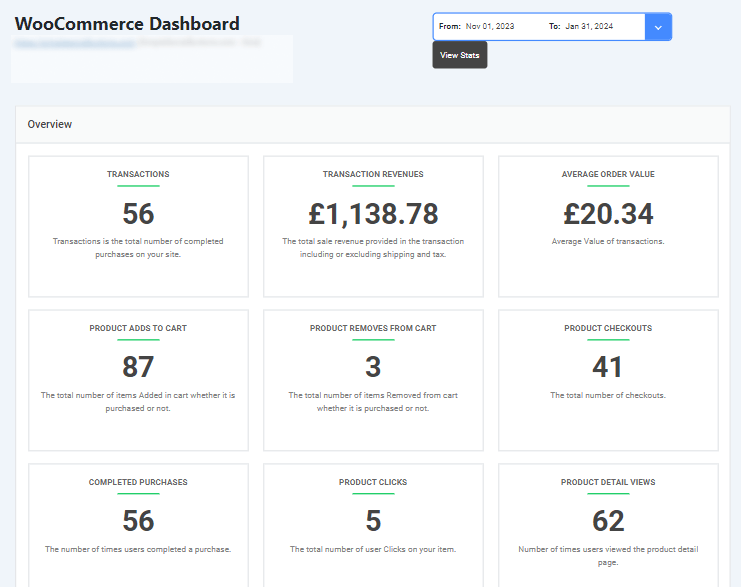
15 Most Common Enhanced Ecommerce Mistakes (2025)
Are you making Enhanced Ecommerce mistakes affecting your data accuracy and decision-making? Enhanced Ecommerce via Google Tag Manager (GTM) allows you to track a wide range of user interactions, from product impressions to purchases. Even minor errors in implementation can lead to incomplete or incorrect data, which ultimately impacts your ability to optimize your ecommerce site.
In this blog, we’ll explore the most common Enhanced Ecommerce mistakes often occurring during GTM and GA4 implementation. We’ll also discuss how these ecommerce mistakes in GTM and GA4 can impact your ability to collect reliable data, and share best practices to help you avoid these errors.
Enhanced eCommerce Mistakes (TOC):
What is Enhanced Ecommerce?
Enhanced Ecommerce is a powerful feature within Google Analytics (GA4) that enables businesses to gain deep insights into their ecommerce performance. Unlike basic ecommerce tracking, which focuses solely on tracking completed transactions, Enhanced Ecommerce tracks multiple user interactions across the entire purchase funnel. This includes actions such as product impressions, add-to-cart events, product clicks, checkout steps, and transactions.
When implemented via Google Tag Manager (GTM), Enhanced Ecommerce allows marketers to manage the tracking setup efficiently without modifying the website’s source code. GTM acts as an intermediary, simplifying the integration of various tags, triggers, and variables necessary for comprehensive tracking. It ensures that all relevant user interactions are captured and sent to Google Analytics, providing detailed reports on customer behavior.
By using GTM to implement Enhanced Ecommerce, businesses can track key metrics such as:
- Product Impressions: When products are viewed by users.
- Add-to-Cart Events: When users add products to their shopping cart.
- Checkout Steps: Monitoring where users abandon the checkout process.
- Transactions: Successful purchases made by users.
Most Common Enhanced Ecommerce Mistakes
Let’s know some basic and common enhanced ecommerce mistakes when implemented with GA4 and GTM.
1. Not Enabling Enhanced Ecommerce Feature in Google Analytics Admin Settings
Before any data collection occurs, you must enable the Enhanced Ecommerce feature within your Google Analytics property settings. Enhanced measurement is by default on, but sometimes it can be accidentally off by someone. It can then be the simple reason behind enhanced ecommerce mistakes.
Failing to flip this crucial switch means GTM will send data to GA, but your reports will remain blank. This step is easy to overlook when you’re focused on the technical setup of tags and triggers.
2. Not Coordinating with Developers for Proper DataLayer Implementation
If you’re not coordinating with developers for proper datalayer implementation, it’s most probably that you’ll face enhanced ecommerce mistakes. Enhanced Ecommerce (EE) tracking relies heavily on well-structured dataLayer pushes. If you (the marketer or analyst) and your developers aren’t aligned on which data points need to be pushed (e.g., product ID, name, price, currency), you’ll likely face gaps in your reporting. A common mistake is expecting the dataLayer to magically appear without giving developers a clear specification of how to format that data. This leads to missing or malformed data, making your EE reports incomplete or inaccurate.
3. Copy-Pasting Code Without Understanding It
Many EE setups fail because code snippets or dataLayer pushes are simply copied from a tutorial without being adapted to your site’s funnel flow. For instance, if you’re grabbing code that tracks “Add to Cart” but your own site triggers cart additions via a different process, you’ll end up with faulty or duplicated data. Take time to learn how each snippet works, what variables it uses, and how it ties into your site’s user journey. This investment ensures you have consistent, reliable tracking data from the start.
4. Incorrect or Inconsistent Data Layer Configuration
Enhanced Ecommerce in Google Tag Manager is powerful but also strict. One of the most prominent mistakes marketers and developers make is pushing Ecommerce data into the dataLayer without following the exact structure and naming conventions outlined by Google.
Here’s how it works:
When a user interacts with your store (views a product, adds to cart, completes a checkout, etc.), a developer must push that event’s data into the dataLayer. Then, GTM reads that data and fires the relevant Enhanced Ecommerce tag to send it to Universal Analytics or GA4.
But here’s the golden rule: Google only accepts data in the exact structure it expects. If you break the format or rename fields, it won’t work. So, no tracking, no insights, no sales data.
Here’s a correct example for an “add to cart” event:
window.dataLayer = window.dataLayer || [];
window.dataLayer.push({
event: 'addToCart',
ecommerce: {
currencyCode: 'USD',
add: {
products: [{
id: 'sku-789',
name: 'Eco-Friendly Water Bottle',
category: 'Home & Kitchen',
variant: 'Green',
brand: 'HydroSmart',
price: 24.99,
quantity: 1
}]
}
}
});This structure follows three important rules:
- Correct object names: ecommerce, add, and products are all standard and required.
- Proper data types: The products field must always be an array, even if there’s only one product.
- Standardized attribute names: Use id, name, price, and quantity exactly as defined in Google’s documentation. Do not use custom names like product_id or qty.
Here’s what not to do:
window.dataLayer.push({
event: 'addToCart',
ecommerce: {
cartAdd: {
items: [{
product_id: 'sku-789',
title: 'Eco-Friendly Water Bottle',
cost: 24.99,
qty: 1
}]
}
}
});This will fail silently. GTM won’t recognize cartAdd, items, or the custom field names. Even worse, your reports will remain empty, and you won’t know why.
If you want your tracking setup to work like a well-oiled machine, always refer to the official Enhanced Ecommerce schema, and double-check that all field names and formats are valid.
5. Failing to Ensure Data Consistency Across Funnel Steps
One major (but often overlooked) mistake in Enhanced Ecommerce implementation via Google Tag Manager is not keeping product data consistent across every stage of the customer journey.
It happens more than you’d think: developers push complete product data during the “add to cart” stage, but then send only partial or mismatched info during checkout or purchase. The result? Broken attribution, missing product insights, and inaccurate revenue reports in Google Analytics.
The Problem:
Imagine you track a user adding a product to the cart with full details like product name, ID, brand, and price. But then, during the purchase step, only the product ID is sent and no name, no brand, no price.
Now your GA reports are confused. It’s like trying to follow a story where the main character disappears halfway through. This data inconsistency breaks your funnel tracking and leads to incomplete or misleading analytics.
The Fix: Keep It Consistent from Start to Finish
You need to persist and pass the same product details across all funnel steps from product impression to checkout to final purchase.
Why Consistency Matters
- Attribution Accuracy: If data varies between steps, Google Analytics may treat them as different products.
- Funnel Drop-off Analysis: You need identical product info to compare how many users added it to the cart vs. completed the purchase.
- Custom Dimensions: If you’re tracking attributes like course difficulty or instructor via custom dimensions, ensure these are product-scoped and persist across all events.
Pro Tip: Work With Your Developer
Make it a standard practice to reuse the same product object or source of truth across funnel steps. This ensures that no detail gets lost along the way.
With clean, consistent product data flowing through every stage of the customer journey, your Enhanced Ecommerce reports will be more reliable and your business decisions a whole lot smarter.
6. Incorrect Configuration of Checkout Funnel Steps
A common mistake is incorrectly configuring the checkout funnel in Google Tag Manager. The checkout funnel is intended to track the steps a user takes after adding a product to the cart, such as entering billing information, choosing shipping options, and completing the purchase. Many times, marketers mistakenly include product views or other unrelated steps in the checkout funnel, which leads to inaccurate funnel visualization.
Solution:
To resolve this, make sure you follow the proper setup for the checkout funnel. The key here is to track only the steps that are directly related to the checkout process. Here’s how to do it:
- Only Include Relevant Steps:
The checkout funnel should include steps like:
- Billing Information: When users enter their payment details.
- Shipping Information: When users choose their shipping method.
- Review Order: When users review the details before confirming the purchase.
- Billing Information: When users enter their payment details.
- The purchase step should not be part of the funnel but should be tracked separately as an ecommerce.purchase event.
- Correct Triggering:
In Google Tag Manager, set up triggers that accurately capture these steps. For example:
- For the billing information step, set up a trigger that fires when users reach the billing page.
- For the shipping information step, trigger the event when users are on the shipping details page.
- The purchase event should be tracked after the user confirms their order.
- For the billing information step, set up a trigger that fires when users reach the billing page.
- Avoid Over-Tracking:
Ensure that you’re not tracking irrelevant steps like product views or add-to-cart events in the checkout funnel. These should be tracked separately as part of the user’s journey before the checkout process.
By configuring the checkout funnel accurately, you’ll get a clearer picture of where users drop off and where improvements are needed.
7. Passing Custom Dimensions at the Wrong Level
Custom dimensions are often passed incorrectly, either at the wrong level (e.g., the GA tag or the GA Settings Variable) or not at the right scope. For example, if you’re trying to track product attributes like size, color, or brand, and you set these at the session or user level instead of the product level, your data will not be accurate.
Solution:
To fix this, pass custom dimensions at the correct scope and level. Here’s what you should do:
Track Product-Level Custom Dimensions:
When tracking product-specific details like size or color, ensure that these custom dimensions are tied to the product level, not the session or user level. This allows you to accurately measure the performance of individual products based on these attributes.
Example:
window.dataLayer.push({
event: 'purchase',
ecommerce: {
purchase: {
actionField: { id: '12345' },
products: [{
id: 'prod123',
name: 'Product Name',
size: 'L',
color: 'Red',
price: '99.99',
quantity: 1
}]
}
}
});Use Product-Specific Custom Dimensions:
When setting up custom dimensions in Google Analytics or GTM, make sure the dimensions are defined as product-scoped in the GA Admin settings. This ensures that these dimensions are properly recorded at the product level.
Avoid Overloading Custom Dimensions:
If you track too many custom dimensions, you risk exceeding Google Analytics limits, which could prevent your data from being recorded. Stick to the most essential custom dimensions that provide actionable insights.
By ensuring that custom dimensions are set up properly at the correct scope (e.g., product-scoped), your ecommerce data will be more accurate, helping you make informed decisions based on product attributes.
8. Forgetting to Track Product ID or Product Name
One of the most fundamental mistakes in Enhanced Ecommerce tracking is forgetting to include the Product ID or Product Name in the dataLayer when tracking events like add-to-cart, purchase, or product views. Without these key identifiers, Google Analytics will show “(not set)” in your reports, making it impossible to analyze product performance effectively.
Solution:
To resolve this, include Product ID and Product Name in every relevant ecommerce event. Here’s how:
Ensure Consistent Product Tracking:
Always include the Product ID and Product Name in the dataLayer for any event where product data is involved (e.g., add-to-cart, product clicks, and purchase). These identifiers help maintain accurate product-level reporting in Google Analytics.
Example:
window.dataLayer.push({
event: 'addToCart',
ecommerce: {
add: {
products: [{
id: 'prod123',
name: 'Product Name',
price: '99.99',
quantity: 1
}]
}
}
});Track Key Product Data:
Apart from the Product ID and Product Name, consider tracking other important product attributes (e.g., category, price, or SKU) as part of the ecommerce object in the dataLayer. This ensures your Google Analytics reports are enriched with detailed product information.
Test Your Implementation:
Use GTM’s Preview and Debug mode to verify that Product IDs and Product Names are being pushed correctly to the dataLayer. Make sure these values are appearing in your Google Analytics reports.
By consistently including Product IDs and Product Names, you’ll ensure your Enhanced Ecommerce reports are meaningful, allowing you to analyze product performance with precision.
9. Trying to Send Multiple Actions in one dataLayer.push
One mistake many make when implementing Enhanced Ecommerce through Google Tag Manager is trying to send multiple actions (such as product click and product detail) in a single dataLayer.push(). This can lead to incorrect data firing or event conflicts, making it harder to track each user interaction individually.
Solution:
To fix this, it’s essential to keep each event and action separate by sending them as individual dataLayer.push() calls. Here’s the correct approach:
Separate Actions for Different Events:
Instead of combining multiple events (e.g., product clicks and product details) in one dataLayer.push(), create separate dataLayer.push() calls for each event. This ensures that each event is tracked independently.
Example: Product Click Event
window.dataLayer.push({
event: 'eec.productClick',
ecommerce: {
click: {
actionField: { list: 'Related products' },
products: [{
id: '123456abc',
name: 'Some product',
brand: 'Brand Name'
}]
}
}
});Product Detail Event:
window.dataLayer.push({
event: 'eec.productDetail',
ecommerce: {
detail: {
products: [{
id: '123456abc',
name: 'Some product',
brand: 'Brand Name'
}]
}
}
});Use Different Triggers for Separate Events:
In Google Tag Manager, set up different triggers to fire when specific events occur. For instance, use one trigger for when a product is clicked, and another for when a user views a product’s detailed page.
By separating the events and firing them independently, you ensure better data collection and more accurate tracking in Google Analytics.
10. Misunderstanding Checkout and Checkout Option Events
Another common error is confusing the checkout and checkout_option events in Enhanced Ecommerce. These events have distinct purposes, and misunderstanding their function can lead to missing or misinterpreted data in your reports. The checkout event tracks the checkout steps (e.g., billing or shipping), while the checkout_option event tracks additional options, like payment methods.
Solution:
To avoid this mistake, follow these guidelines:
Use the Correct Event Type for Each Step:
- The checkout event should be used for each step a user takes during the checkout process (e.g., entering shipping information and payment details).
- The checkout_option event should be used when tracking the selection of payment methods or shipping options.
Example for checkout:
window.dataLayer.push({
event: 'eec.checkout',
ecommerce: {
checkout: {
actionField: { step: 1 },
products: [{
id: 'prod123',
name: 'Product Name',
price: '99.99',
quantity: 1
}]
}
}
});Example for checkout_option:
window.dataLayer.push({
event: 'eec.checkoutOption',
ecommerce: {
checkout_option: {
actionField: { step: 1, option: 'Credit Card' }
}
}
});Correctly Order the Events:
Ensure that the checkout event fires before the checkout_option event for each step. For example, checkout should be fired when the user enters billing info, and checkout_option should be triggered when they select a payment method.
By distinguishing between these two event types, you ensure accurate tracking of each stage of the checkout process and can optimize accordingly.
11. Sending Enhanced Ecommerce Data Before the Pageview Tag
Sending Enhanced Ecommerce data before the pageview tag is a mistake that affects bounce rate and other reporting metrics. Since Enhanced Ecommerce events are considered interactions, firing them before the pageview can cause inaccurate data, particularly a falsely low bounce rate.
Solution:
To solve this, configure Google Tag Manager to send Enhanced Ecommerce data after the pageview tag is fired. This ensures the pageview is correctly recorded before other interactions, preserving accurate session data.
Ensure Correct Tag Firing Order:
In GTM, ensure that your pageview tag fires first. After that, you can fire Enhanced Ecommerce event tags (like add-to-cart, product impressions, etc.) as non-interaction hits. This ensures that only the pageview counts as the first interaction.
Set Non-Interaction for Ecommerce Events:
To avoid skewing bounce rates, set Enhanced Ecommerce event tags to non-interaction. This ensures that they don’t count as interactions that would impact your bounce rate.
By following this order, you ensure more accurate reporting and prevent any misrepresentation of your site’s performance.
12. Exceeding the 8KB Request Size Limit for Google Analytics
One often-overlooked mistake when implementing Enhanced Ecommerce is exceeding the 8KB request size limit for Google Analytics. This occurs when too much data is sent in a single hit, particularly when tracking multiple products, custom dimensions, or extensive event data. Google Analytics has an 8KB limit per request, and if this limit is exceeded, the data won’t be recorded.
Solution:
To resolve this, consider these best practices:
- Reduce the Amount of Data Sent:
- If you’re tracking multiple products, make sure only the necessary data (e.g., product ID, price, quantity) is included. Avoid sending too many custom dimensions or excessive details that might push the request size over the limit.
- Instead of sending large product arrays or custom data in a single hit, consider splitting the data into smaller requests.
- If you’re tracking multiple products, make sure only the necessary data (e.g., product ID, price, quantity) is included. Avoid sending too many custom dimensions or excessive details that might push the request size over the limit.
- Implement Request Size Monitoring:
You can monitor and log when you exceed the 8KB limit using custom dimensions or monitoring tools. If you’re approaching the limit, it might be time to optimize your data transmission or split requests. - Optimize Product Data:
- If you’re tracking products with large quantities of attributes (e.g., product descriptions, long lists of categories), reduce the number of attributes being sent in the request.
- Use shortened or truncated values for product names or descriptions, ensuring the necessary information is passed within the 8KB constraint.
- If you’re tracking products with large quantities of attributes (e.g., product descriptions, long lists of categories), reduce the number of attributes being sent in the request.
By monitoring and optimizing your requests, you can avoid hitting the 8KB limit and ensure your data is sent successfully to Google Analytics.
13. Failing to Set Up Conversion Tracking with Google Ads or Facebook Pixel
One critical mistake businesses often make is failing to set up conversion tracking with Google Ads or Facebook Pixel when implementing Enhanced Ecommerce. Without proper conversion tracking, it becomes challenging to determine which marketing efforts are driving actual sales, making it difficult to optimize your campaigns effectively.
Solution:
To avoid this mistake, you need to integrate Google Ads and Facebook Pixel with Google Analytics through Google Tag Manager. This ensures that conversions are tracked and attributed accurately across platforms. Here’s how you can set it up:
- Google Ads Conversion Tracking:
- Link your Google Analytics account with Google Ads.
- In GTM, create a new tag for Google Ads Conversion Tracking using your conversion ID and label.
- Set the trigger to fire when a transaction is completed (e.g., on the “purchase” event).
- Link your Google Analytics account with Google Ads.
Read our complete guide on How to Link Google Ads to Google Analytics.
- Facebook Pixel Tracking:
- Go to Facebook Ads Manager and get your Pixel ID.
- Create a new tag in GTM for the Facebook Pixel.
- Use the Pixel’s standard events like Purchase, Add to Cart, or View Content.
- Ensure the pixel fires during the appropriate ecommerce events, such as completing a purchase.
- Go to Facebook Ads Manager and get your Pixel ID.
By setting up conversion tracking, you can accurately measure ROI on your advertising spend and improve remarketing efforts.
14. Not Properly Handling Cross-Domain Tracking
Cross-domain tracking is a common area where many GTM implementations go wrong. If your ecommerce site spans multiple domains (for example, a shopping site and a checkout domain), session continuity can be lost when users navigate between them, causing fragmented data. This leads to inaccurate user journeys, such as falsely reporting abandoned carts or incomplete transactions.
Solution:
To fix this, you need to configure cross-domain tracking within GTM and Google Analytics. Here’s how to properly set it up:
- Configure GTM for Cross-Domain Tracking:
- Open GTM, go to the Variables section, and create a new Auto-Event Variable for Page Hostname.
- In GTM, edit the Universal Analytics tag and add the domains you want to track in the Cross Domain Tracking field. This tells Google Analytics to track the user’s session across multiple domains.
- Open GTM, go to the Variables section, and create a new Auto-Event Variable for Page Hostname.
- Modify the Google Analytics Tag:
- Under the More Settings section of the Universal Analytics tag, add the domains that need to be tracked in the Cross Domain Tracking field.
- For example, if your site is example.com and the checkout domain is checkout.example.com, list both of these in the cross-domain field.
- Under the More Settings section of the Universal Analytics tag, add the domains that need to be tracked in the Cross Domain Tracking field.
- Adjust for Session Linking:
- Ensure that your cookie settings are configured correctly. This allows session data (like user IDs) to persist even as users move between domains.
For WordPress users, setting up cross-domain tracking is easy with Analytify.
15. Not Using A/B Testing for Ecommerce Pages
Many businesses fail to utilize A/B testing on their ecommerce pages. Without A/B testing, it’s hard to know which design elements, copy, or calls to action are converting the best. This results in missed opportunities to optimize your site and boost conversions.
Solution:
A/B testing allows you to test different versions of a webpage to see which one performs better. Here’s how to set it up and optimize your ecommerce site:
- Use Google Optimize for A/B Testing:
- Google Optimize integrates seamlessly with Google Analytics and GTM, allowing you to easily create A/B tests on your ecommerce pages.
- In Google Optimize, create a test (e.g., comparing two versions of your product page) and define the metric you want to optimize (e.g., conversion rate).
- Add the Optimize container snippet to your website via GTM to make sure the A/B test runs effectively.
- Google Optimize integrates seamlessly with Google Analytics and GTM, allowing you to easily create A/B tests on your ecommerce pages.
- Set Up Tags in GTM:
- In GTM, ensure the correct Google Analytics events are fired when a user interacts with your A/B test variations.
- For example, if you’re testing product pages, track events such as Add to Cart, Product Views, and Purchases. This will allow you to analyze which version of the page performs better.
- In GTM, ensure the correct Google Analytics events are fired when a user interacts with your A/B test variations.
- Analyze Test Results:
- After running the A/B test for a sufficient amount of time, analyze the results in Google Analytics and Google Optimize. Look for significant differences in conversion rates, bounce rates, or any other key metrics.
- Once you identify the winning variation, implement it permanently to improve your ecommerce site’s performance.
- After running the A/B test for a sufficient amount of time, analyze the results in Google Analytics and Google Optimize. Look for significant differences in conversion rates, bounce rates, or any other key metrics.
By using A/B testing, you can continuously refine your ecommerce pages to enhance the customer experience and drive higher conversions.
Enhanced Ecommerce Tracking with Analytify: For WordPress Users
Join 50,000+ beginners & professionals who use Analytify to simplify their Google Analytics!
Analytify simplifies the process of setting up Enhanced Ecommerce in Google Analytics, making it easier for WordPress users to track and analyze detailed ecommerce data without the need for complex configurations or code.
Seamless Integration with Google Analytics
Analytify automatically connects Google Analytics with your WordPress site, syncing essential ecommerce data like product impressions, add-to-cart actions, and transactions into your Google Analytics reports with minimal setup.
User-Friendly Reporting
The plugin provides a visual dashboard where you can monitor Enhanced Ecommerce metrics directly within WordPress, including revenue, transactions, and product performance, without having to navigate Google Analytics.
Simplified Custom Tracking
Analytify makes it easy to track custom dimensions and metrics, such as product attributes and user behavior, all from within the plugin. This reduces the complexity of GTM setups and ensures accurate data collection.
WooCommerce Integration
For WooCommerce users, Analytify offers seamless integration, automatically tracking ecommerce events and product performance without manual configuration.
With Analytify, you can streamline Enhanced Ecommerce setup and reporting, saving time on tracking and focusing more on actionable insights.
FAQs About Enhanced eCommerce Mistakes
1. What are the essential steps for implementing Enhanced Ecommerce with GTM?
To implement Enhanced Ecommerce with Google Tag Manager (GTM), follow these essential steps:
Set up the Data Layer: Ensure your website’s dataLayer is correctly configured to pass ecommerce data (like product impressions, add-to-cart events, and transactions).
Create Tags in GTM: Set up Universal Analytics tags or GA4 event tags to capture each ecommerce action (e.g., add-to-cart, checkout steps).
Configure Triggers: Define triggers for each event, such as product views or checkout steps, to fire the appropriate tags at the right time.
Test the Setup: Use GTM’s Preview mode to test and debug your tracking setup before publishing it.
2. How do I troubleshoot issues with Enhanced Ecommerce data not showing in GA?
If your Enhanced Ecommerce data is not appearing in Google Analytics, check the following:
Verify Tag Firing: Ensure your GTM tags are firing correctly on the right events by using the Preview mode.
Check Data Layer: Confirm that the dataLayer is pushing the correct ecommerce data (like product IDs and transaction data) and is formatted correctly.
Test Conversion Tags: Ensure your conversion tracking tags for Google Ads or Facebook Pixel are firing on the correct pages or events.
What are some common Enhanced Ecommerce mistakes to avoid?
Some of the most common Enhanced Ecommerce mistakes include:
Incorrect data layer structure (e.g., missing product IDs, prices, or category values)
Firing ecommerce events on page load instead of user interaction, leading to duplicate transactions
Not setting currency values correctly, which causes reporting mismatches in GA4.
Mixing standard ecommerce and enhanced ecommerce setups, confusing Google Tag Manager and GA4
To avoid these, always validate your setup using GTM’s Preview Mode and Google’s Tag Assistant.
What are the most common Enhanced Ecommerce mistakes in GTM?
In Google Tag Manager (GTM), common Enhanced Ecommerce mistakes include:
Incorrect trigger conditions, such as firing purchase events on all pages
Wrong variable mappings, like using the wrong data layer variable for transaction ID
Missing event names (e.g., purchase, view_item_list, etc.) required for GA4 Ecommerce
Improper tag sequencing, where the ecommerce tag fires before the data layer is ready
How can I fix ecommerce tracking mistakes in GTM?
To fix ecommerce tracking issues in GTM:
Audit your data layer to ensure it follows Google’s Enhanced Ecommerce structure
Verify trigger accuracy so that tags fire only when the correct actions occur
Use GA4’s DebugView and GTM Preview mode to test the flow of events and parameters
Check for missing required parameters, like currency, value, items, etc.
Enhanced eCommerce Mistakes: Conclusion
Implementing Enhanced Ecommerce through Google Tag Manager (GTM) is necessary for businesses looking to track detailed user interactions, improve their marketing strategies, and boost conversions. However, as we’ve discussed, common enhanced ecommerce mistakes can lead to inaccurate data and missed optimization opportunities.
By avoiding the mistakes mentioned, such as incorrect dataLayer configuration, not setting up proper conversion tracking, and misunderstanding the checkout funnel, you can ensure a more reliable and effective setup.
We hope this article helped you to avoid the most common enhanced ecommerce mistakes.
Further Readings:
How to Fix Google Analytics Not Working?
13 Easy Ways to Learn Google Analytics 4
Now, we’d love to hear from you. What enhanced ecommerce mistakes were you making with your GTM setup? Share your thoughts in the comment box.







